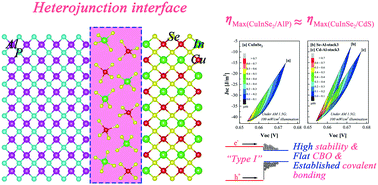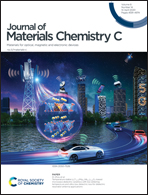First-principles calculations on CuInSe2/AlP heterostructures†
Abstract
Heterostructures based on a CuInSe2 absorber with an AlP buffer have been modeled for the first time using different stacking schemes and interfacial terminations. Mechanical, electronic and topological properties of CuInSe2/AlP heterostructures along the [001] direction were investigated using the full potential linear augmented plane wave (FP-LAPW) method. Optimal interfacial distance, thermodynamic stability and band alignment have been computed systematically. A heterointerface with “on-top” stacking is thermodynamically the most stable compared with other stackings. The magnitudes of core level binding energy differences are in accordance with interfacial adhesion energies. Absolute deformation potentials (ADPs) of band energies as a function of (001) biaxial strain were determined. With redressing of ADPs, the revised valence and conduction band offsets have increased and decreased, respectively. AlP has strong resistance to biaxial strain in the evolution of band energy edges. Topological properties and density of states were used to investigate the relationship between interatomic interactions and energy band evolution. The most stable CuInSe2/AlP heterostructures have “spike-like” band offsets, with the one terminated as Se–Al characterized by a flat conduction band offset of 12 meV. This comes from the strong “Cu d-Se p” states hybridization. The theoretical maximum conversion efficiency of the AlP-based “absorber-buffer” heterostructure is 27.39% at 0.5 μm thickness.



 Please wait while we load your content...
Please wait while we load your content...